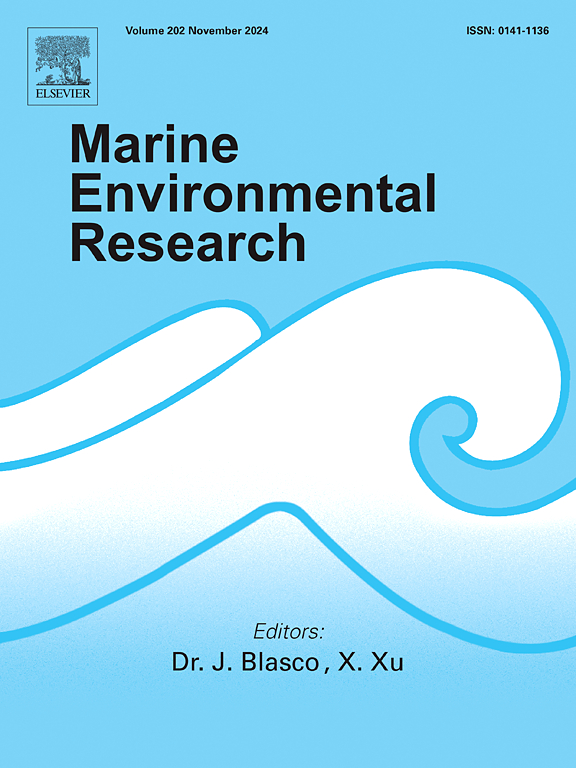Chemical interactions between filter-feeding mussels and Ulva prolifera: The role of dissolved organic matter and secondary metabolites in growth promotion and competition inhibition of algal species
IF 3.2
3区 环境科学与生态学
Q2 ENVIRONMENTAL SCIENCES
引用次数: 0
Abstract
This review examines the chemical and ecological interactions between filter-feeding mussels and the green macroalga Ulva prolifera in integrated multi-trophic aquaculture (IMTA) systems. Mussels are crucial for nutrient recycling, as they filter water and release bioavailable compounds such as ammonium (NH4+), urea (CO(NH2)2), and dissolved organic matter (DOM). These compounds promote Ulva growth and enhance microbial activity. In turn, U. prolifera produces sulfated polysaccharides, phenolics, and halogenated metabolites that can influence microbial communities, suppress competitors, and potentially affect mussel physiology at high concentrations. The review emphasizes the interconnectedness of nutrient exchange, DOM cycling, and microbial genes such as pmoA and mcrA, highlighting the novelty of integrating microbial ecology with biogeochemical cycles and ecosystem outcomes, illustrating both the synergies and risks present in co-culture systems. While moderate production of metabolites helps control biofouling and maintain ecosystem stability, excessive DOM or allelochemical accumulation can hinder mussel filtration and lead to hypoxia. Maintaining specific thresholds, such as DOM concentrations below 5 mg C/L and labile-to-refractory DOM ratios above 1:1, is essential for balance. This synthesis integrates microbial ecology, metabolite feedbacks, and biogeochemical processes to provide a framework for resilient IMTA design. It also emphasizes practical strategies like adjusting stocking densities, optimizing water exchange, and employing microbial monitoring tools to promote sustainable IMTA practices. By linking molecular interactions to ecosystem-scale outcomes, the review offers guidance for sustainable aquaculture systems that enhance productivity, minimize environmental risks, and improve resilience in the face of climate stress.
滤食性贻贝与增生Ulva的化学相互作用:溶解有机物和次生代谢物在促进藻类生长和抑制竞争中的作用
本文综述了综合多营养养殖(IMTA)系统中滤食性贻贝与绿巨藻间的化学和生态相互作用。贻贝对养分循环至关重要,因为它们过滤水并释放生物可利用的化合物,如铵(NH4+)、尿素(CO(NH2)2)和溶解的有机物(DOM)。这些化合物促进Ulva生长,增强微生物活性。反过来,在高浓度的情况下,增菌菇产生硫酸酸化的多糖、酚类物质和卤化代谢物,这些物质可以影响微生物群落,抑制竞争对手,并可能影响贻贝的生理。这篇综述强调了养分交换、DOM循环和微生物基因(如pmoA和mcrA)的相互联系,强调了将微生物生态学与生物地球化学循环和生态系统结果相结合的新颖性,说明了共培养系统中存在的协同效应和风险。适度产生代谢物有助于控制生物污染和维持生态系统稳定,但过量的DOM或化感物质积累会阻碍贻贝的过滤并导致缺氧。维持特定的阈值,如DOM浓度低于5 mg C/L,不稳定与难降解DOM的比例高于1:1,对平衡至关重要。这种综合整合了微生物生态学、代谢物反馈和生物地球化学过程,为弹性IMTA设计提供了框架。它还强调了调整放养密度、优化水交换和采用微生物监测工具等实用策略,以促进可持续的IMTA实践。通过将分子相互作用与生态系统规模的结果联系起来,该综述为可持续水产养殖系统提供了指导,以提高生产力,最大限度地减少环境风险,并提高面对气候压力的复原力。
本文章由计算机程序翻译,如有差异,请以英文原文为准。
求助全文
约1分钟内获得全文
求助全文
来源期刊

Marine environmental research
环境科学-毒理学
CiteScore
5.90
自引率
3.00%
发文量
217
审稿时长
46 days
期刊介绍:
Marine Environmental Research publishes original research papers on chemical, physical, and biological interactions in the oceans and coastal waters. The journal serves as a forum for new information on biology, chemistry, and toxicology and syntheses that advance understanding of marine environmental processes.
Submission of multidisciplinary studies is encouraged. Studies that utilize experimental approaches to clarify the roles of anthropogenic and natural causes of changes in marine ecosystems are especially welcome, as are those studies that represent new developments of a theoretical or conceptual aspect of marine science. All papers published in this journal are reviewed by qualified peers prior to acceptance and publication. Examples of topics considered to be appropriate for the journal include, but are not limited to, the following:
– The extent, persistence, and consequences of change and the recovery from such change in natural marine systems
– The biochemical, physiological, and ecological consequences of contaminants to marine organisms and ecosystems
– The biogeochemistry of naturally occurring and anthropogenic substances
– Models that describe and predict the above processes
– Monitoring studies, to the extent that their results provide new information on functional processes
– Methodological papers describing improved quantitative techniques for the marine sciences.
 求助内容:
求助内容: 应助结果提醒方式:
应助结果提醒方式:


